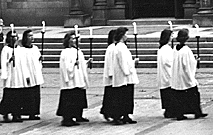I was Our Lady's Juggler: A Memory
By Conna Bell Shaw '28
Now at the advancing age of 91, I had been going through my files when I came upon a bulging folder marked "Our Lady's Juggler." There, in my crowded study near Washington, D.C., the years fell away for a few hours, and I was back on tha plaza of Finney Chapel in Oberlin at twilight on a May night in 1927.
I'm dressed in tights and a multi-colored blouse, juggling three gilded balls, dancing and tumbling before the statue of the Blessed Virgin. A hushed group of awed spectators is seated on the bleachers erected for this three-night occasion on the street
in front of the chapel. Never before in Oberlin -- or since -- has any event in-volved so many students, so much faculty support and leadership, and such enthusiastic audience participation from surrounding communities.
|
Unique to Oberlin were the facilities of
the Conservatory upon which we could draw. Three musical groups were involved: the À Cappella Choir, the Madrigal Singers, and the Oberlin Symphony Orchestra which furnished the musical accompaniment for the entire production.
|  Most of the photographs here are from the 1939 performance, provided by Conna Bell Shaw |
Oberlin's involvement began when Professor Fred Artz spent the summer of 1926 traveling in France, where he had become familiar with the old legend of the unlettered itinerant juggler and the miracle-working Virgin. On his way home, leisurely crossing the Atlantic by ship that August, he envisioned such an odyssey being performed, somehow, on the plaza of our new renaissance chapel, and sketched out in his mind's eye a bare-bones, three-act drama.
Back in Oberlin, he presented his ideas to Gertrude Moulton, head of the women's physical education department, who immediately saw the possibilities as a project for the Women's Athletic Association (W.A.A.). In those days, every female student belonged automatically to the association. Dr. Moulton, in turn, involved her faculty and the student officers of the W.A.A. An elaborate production cast was appointed, with students heading production, music, costume, dance, publicity, and finance
committees.
I was asked as early as October 1926 to be The Juggler. Juggle? I? Well, yes, I would try anything once, and I set about to find the right size of ball for me to handle.

Pity the poor girls who lived below me that year in Lauderleigh Cottage on Elm Street; all of my spare time went into experimenting. Balls dropped to the floor with a continuity that exasperated me until, finally, as the months passed, I learned not only to juggle three balls, but to tumble, cartwheel, and dance while they were in the air. Meanwhile, the student committees and their faculty advisors were hard at work.
In May of 1927, the first performances of "Our Lady's Juggler" was so successful that in May of 1928, my senior year, the drama was repeated.
Eleven years later, in 1939, my husband, Carroll Kingsley Shaw '28, was working for the college, and we lived in Oberlin with our two small daughters, Betsy and Conna Bell. Someone decided that the college should repeat the performance. The same faculty advisors who had supervised the 1927 and 1928 performances were still available, and I was teaching dance. Would I consider being The Juggler again? Of course I would. I had identified with the role so thoroughly that I still get emotional when I think of those closing moments. And I could still juggle my three balls, walk on my hands, and turn my cartwheels.
There are some light moments I still remember fondly. For instance, much of the practicing for the performance could be done in the women's gymnasium, but the two dress-rehearsals were held on the chapel plaza at 5:30 a.m. During the rehearsal we needed to ring the chapel bell to call the villagers together. On one occasion, after it rang, a sleepy-eyed, irritated male appeared. "What's going on?" he demanded. "I must be late for my 8 o'clock. Let me through."
Freddie Artz, by this time one of the most admired and/or feared professors on campus, was so involved with details in his struggle to oversee every detail that he seemed to be everywhere at once. After the first dress rehearsal, his good friend Don Love of the faculty, said, "Fred, the inside of the chapel isn't lit, but from the bleachers I can see you dashing around as you cross the doorways. Why don't you dress as one of the friars? That would help." And so Freddie did.

During the intermissions, the Virgin* was removed from her elaborate niche and taken inside the chapel to rest. After the second act I was resting on the back bench in the chapel when I heard the scurry of feet behind me. It was almost time for the third act to begin. I sat up just as Fred ran by me, his sandaled feet brushing the stone pavement, his headpiece askew, the cord of his long friar's robe trailing behind him. "Where in hell is that damned Virgin?"
he was muttering. "It's late. Where is she?
I must find that Virgin."
The impact of Our Lady's Juggler on Oberlinians of the day was unforgettable. For years Carroll and I returned to Oberlin as agents for the Class of 1928, and we con-tinued to meet apparent strangers who would exclaim, "Oh, I remember Our Lady's Juggler!" or "Oh, I was in Our Lady's Juggler!"
I am still active in amateur dramatics. I still dance. Alas, I no longer juggle. Nor do I turn cartwheels! But I certainly will never forget Our Lady's Juggler.
*Charlotte Roth Wilson, now Charlotte
Wilson Marsh, played The Virgin in her
senior year, 1939.